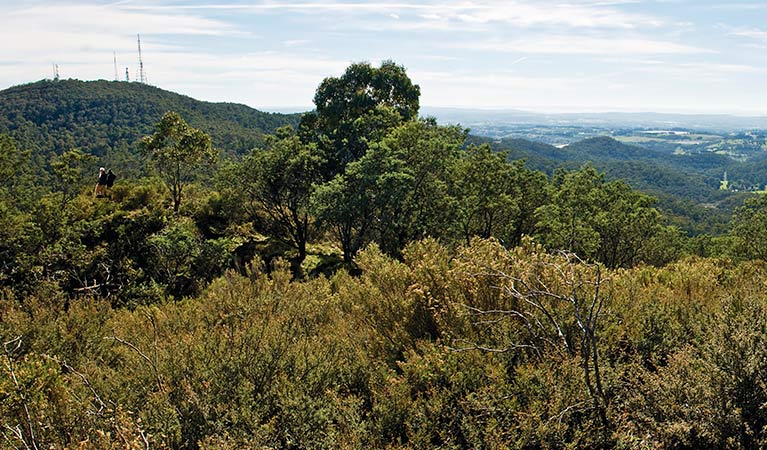Mount Canobolas State Conservation Area
Overview
Mount Canobolas State Conservation Area offers birdwatching, walking, scenic views, pretty picnic areas and a great campground. It's a top choice for a weekend getaway.
Read more about Mount Canobolas State Conservation Area
The majestic Mount Canobolas is a dormant volcano that formed millions of years ago when Australia was sitting over a hotspot in the earth's crust. It is part of the Brigooda-Oberon chain that stretches 800km from southeast Queensland to near Oberon in NSW and last erupted 11 million years ago, spewing lava from the main vent and up to 30 vents in the surrounding area. With its rich soil, high altitude and cool climate, it’s the perfect environment for a range of plants and animals.
There are great places to picnic and a number of walking tracks, plus the park is only a short drive from Orange so it makes for a great daytrip. If you feel like a weekend getaway, there’s also a campground that offers basic facilities in a pretty setting, right near the start of the Federal Falls walking track.
Local alerts
For the latest updates on fires, closures and other alerts in this area, see https://www.nationalparks.nsw.gov.au/visit-a-park/parks/mount-canobolas-state-conservation-area/local-alerts
Map
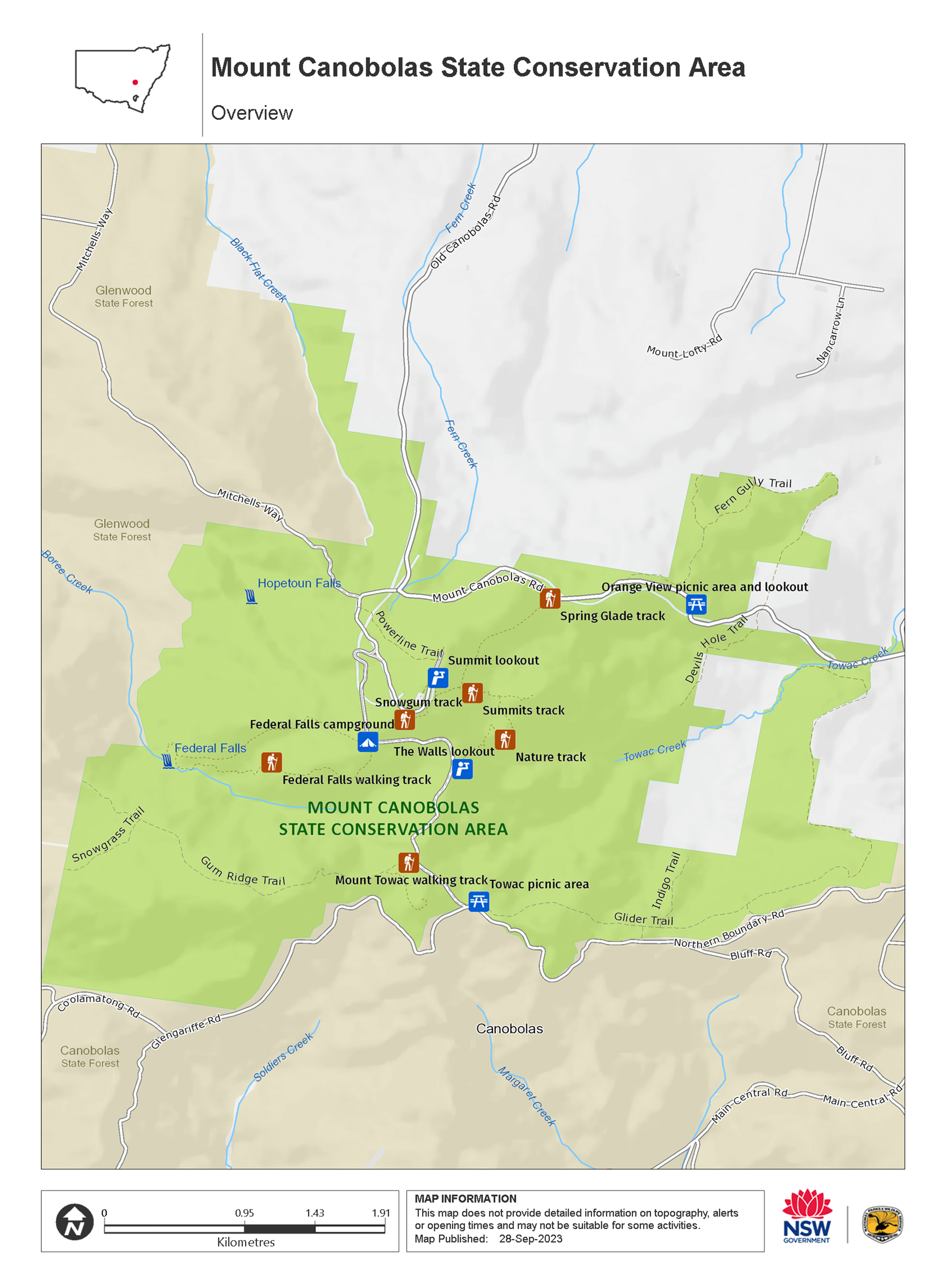
Map legend

Contact
- in the Country NSW region
Mount Canobolas State Conservation Area is always open but may have to close at times due to poor weather or fire danger.
-
-
Bathurst office
02 6332 7640
02 6332 7680 To contact the KARST Conservation Unit in this office.
Contact hours: Monday to Friday, 8.30am to 4.30pm. - Level 2, 203-209 Russell Street, Bathurst NSW 2795
-
Email: npws.centralwest@environment.nsw.gov.au
-
Bathurst office
Visitor info
All the practical information you need to know about Mount Canobolas State Conservation Area.
Getting there and parking
Get driving directions
From Orange, travel west out of town along Cargo Road (A32) and then turn left onto Lake Canobolas Road which becomes Pinnacle Road. Turn right into Mount Canobolas Road.
Parking
- Orange View picnic area and lookout See on map
- Summit lookout See on map
Road quality
- Unsealed roads
Vehicle access
- 2WD vehicles
Weather restrictions
- All weather
By bike
Check out the Bicycle information for NSW website for more information
Best times to visit
There are lots of great things waiting for you in Mount Canobolas State Conservation Area. Here are some of the highlights.
Autumn
Wake up to misty mornings and enjoy clear, sunny skies – it's a magical time of year to visit.
Spring
See the violet kunzea, fringe myrtle and mirbelia flowers blossoming in the heaths around rocky outcrops.
Weather, temperature and rainfall
Summer temperature
Average
13°C and 26°C
Highest recorded
36.7°C
Winter temperature
Average
0°C and 8°C
Lowest recorded
-3.3°C
Rainfall
Wettest month
August
Driest month
March
The area’s highest recorded rainfall in one day
124.2mm
Facilities
Toilets
Picnic tables
Barbecue facilities
Maps and downloads
Prohibited
Pets
Pets and domestic animals (other than certified assistance animals) are not permitted. Find out which regional parks allow dog walking and see the pets in parks policy for more information.
Smoking
NSW national parks are no smoking areas.
Nearby towns
Orange (14 km)
The bustling city of Orange, with its many cafes, restaurants and shopping opportunities, has something for everyone, plus there's a huge range of places to stay. The real highlight is the town's food and wine, so bring your thirst and your appetite.
Millthorpe (36 km)
Millthorpe has several fine restaurants and a wide range of accommodation that includes charming B&Bs and exclusive retreats. Located at the heart of a dynamic food and cool-climate wine region, Millthorpe is also a centre for truffle production in the State.
Molong (45 km)
Follow the heritage walking tour of Molong in Country NSW to see the many fine 19th-century buildings. Wander through craft shops or art galleries and visit nearby historic villages such as Yeoval, Cumnock and Cudal.
Learn more
Mount Canobolas State Conservation Area is a special place. Here are just some of the reasons why:
Ancient connections
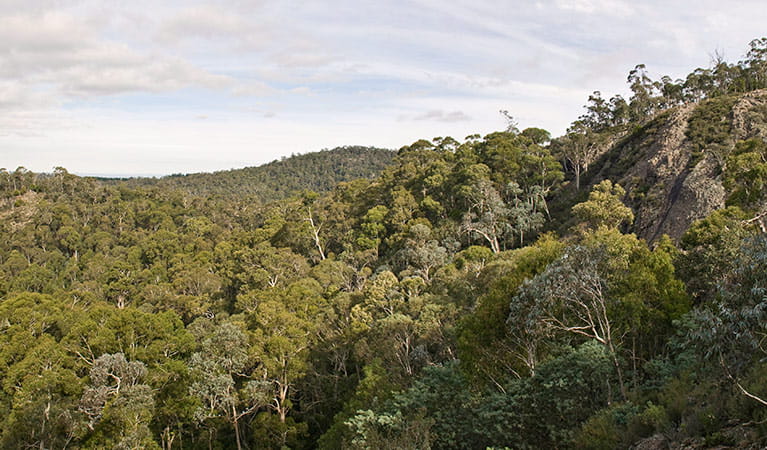
Mount Canobolas State Conservation Area incorporates the traditional land of the Wiradjuri People. The name Canobolas comes from the Wiradjuri words Gaahna Bulla meaning two shoulders, referring to the two main peaks, Old Man Canobolas and Young Man Canobolas. The area has a strong Aboriginal connection as an important place for male initiation ceremonies and stone tool making, as well as being a rich source of food and medicines. Find out more about this area's Aboriginal heritage at Federal Falls campground.
- Summit lookout Summit lookout in Mount Canobolas State Conservation Area is the highest peak in central-west NSW and offers stunning views. Just 18km from Orange and easy to get to, it’s ideal for a quick trip.
An Australian menagerie
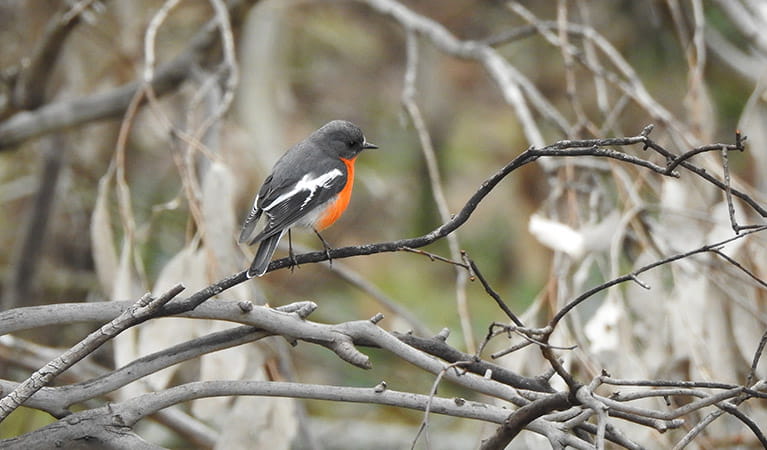
Mount Canobolas has an abundance of native animals which thrive in this special environment. Around 950 species of plants and animals have been recorded in the park, including several species that exist nowhere else in the world. Thornbills, treecreepers, flame robins, wrens and honeyeaters, as well as good old magpies, currawongs, rosellas, kangaroos and wallabies call Mount Canobolas home. Threatened and endangered species like the antechinus marsupial mouse and silver-leaf candlebark can also be found in the area. When the sun goes down, grab your torch to spot the many possums and wombats, all the while being serenaded by the southern boobook owl.
- Snowgum walking track Snowgum walking track is short and easy, it starts from the summit of Mount Canobolas or from Federal Falls campground. It’s a great way to work up a hunger for a barbecue lunch.
- Spring Glade walking track Spring Glade walking track provides easy access to the summit of Mount Canobolas via a pleasant easy walk through grassy woodland, offering birdwatching and picnic opportunities.
Outstanding landscapes
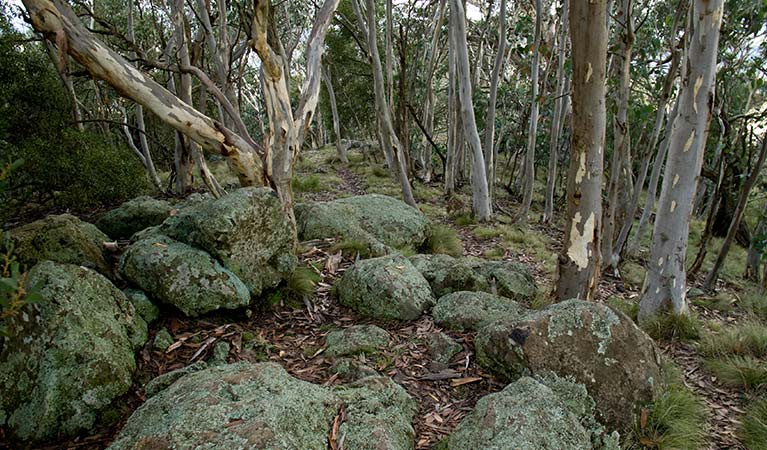
Now extinct and with a violent past, Mount Canobolas was an active and aggressive volcano responsible for creating the landscape between 11 and 13 million years ago. The result? Mount Canobolas State Conservation Area boasts vents, dykes, peaks and plugs which all can be seen here and the large rocky outcrops are home to rare lichens, towering basalt cliff lines and impressive waterfalls. The high altitude, cool climate and moist environment make this fertile ground for more than 300 plant species in the region. Large areas of snow gum subalpine woodland, grassy woodland and rocky outcrops covered with a variety of mosses and lichens make this a great place to visit. It’s hard to say what is most beautiful here, but certainly the heaths in spring which burst with purple, white, yellow and red flowers are a sight to behold.
- Mount Towac walking track This short walk will take you to Towac Peak where you can enjoy panoramic views of Mount Canobolas State Conservation Area and the scenic countryside of Orange.
Plants and animals protected in this park
Animals
-
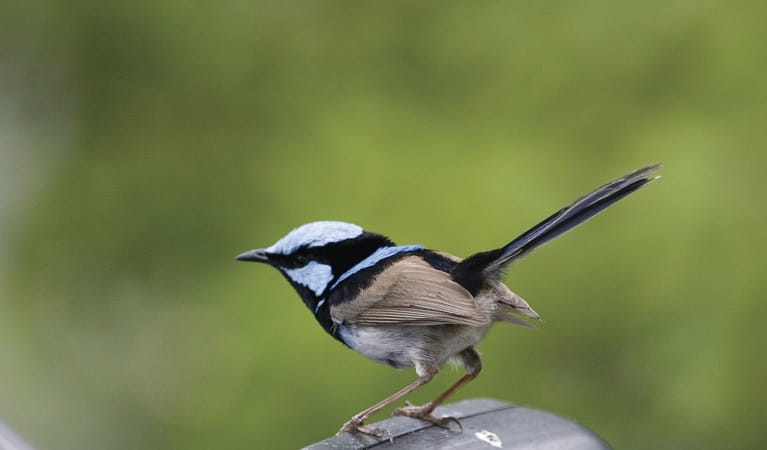
Superb fairy wren (Malurus cyaneus)
The striking blue and black plumage of the adult male superb fairy wren makes for colourful bird watching across south-eastern Australia. The sociable superb fairy wrens, or blue wrens, are Australian birds living in groups consisting of a dominant male, mouse-brown female ‘jenny wrens’ and several tawny-brown juveniles.
-

Common ringtail possum (Pseudocheirus peregrinus)
Commonly found in forests, woodlands and leafy gardens across eastern NSW, the Australian ringtail possum is a tree-dwelling marsupial. With a powerful tail perfectly adapted to grasp objects, it forages in trees for eucalypt leaves, flowers and fruit.
Environments in this park
Education resources (1)
What we're doing
Mount Canobolas State Conservation Area has management strategies in place to protect and conserve the values of this park. Visit the OEH website for detailed park and fire management documents. Here is just some of the work we’re doing to conserve these values:
Managing fire
NSW is one of the most bushfire prone areas in the world as a result of our climate, weather systems, vegetation and the rugged terrain. NPWS is committed to maintaining natural and cultural heritage values and minimising the likelihood and impact of bushfires via a strategic program of fire research, fire planning, hazard reduction, highly trained rapid response firefighting crews and community alerts.
Mount Canobolas is recovering from intense fires that burned nearly 70% of the State Conservation Area in 2018. NPWS staff is working with the Orange Field Naturalist and Conservation Society to monitor, audit, and survey plant vegetation communities, insect and animal species, and Aboriginal sites.
Managing weeds, pest animals and other threats
Pests and weeds have a significant impact to ecosystems within Mount Canobolas State Conservation Area. Reduction of threats, such as foxes and goats, ongoing blackberry control, as well as ongoing risk assessments for new and emerging weeds, is an important part of the work NPWS does to protect the biodiversity values of this conservation area.
Conserving our Aboriginal culture
Mount Canobolas State Conservation Area is dedicated to preserving its strong Aboriginal culture. NPWS liaises with the local land council and other relevant Aboriginal community organisations with regards to the management and interpretation of Aboriginal sites within the area. The service also undertakes Aboriginal sites surveys and works to protect and conserve these key assets throughout the park.

